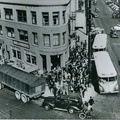Read Part 18 >>
COMMUNITY LIFE
In Hawaii and on the mainland. The Issei established their own hospitals, churches, newspapers, social and cultural organizations, and economic networks. Within their communities they found comfort and comraderie, learning that survival in America meant cooperation, mutual aid and support among themselves.
Since most Issei had come without their extended families, the concept of kinsmen was broadened to include more distant relatives, fellow villagers, and beyond that, the Japanese immigrant community. Community solidarity was high when it came to dealing with the majority group. Showing a “good face” to the haku-jin (Caucasian) was a major concern. Individuals knew that what they did (good or bad) would cast a reflection upon themselves, their families, and also upon their community. “The prevailing attitude was ‘A Japanese delinquent harms us all,’” stated sociologist Harry Kitano.1 Therefore, individuals were expected to subordinate their own interests to that of the community.

Doctor's bag of Dr. Daishiro Kuroiwa, ca. 1920s. (Gift of the Kuroiwa Family, Japanese American National Museum [91.56.1]) Microscope of Dr. Kikuwo Tashiro, ca. 1915. (Gift of Kikuwo Tashiro Family. Japanese American National MUseum [91.55.4.])
BUDDHIST TEMPLES AND CHRISTIAN CHURCHES
Though the Issei were overwhelmingly Buddhist, the first religious institutions to be established in Hawaii and the Mainland were Christian. In Hawaii, both Japanese and haole (white) leaders were convinced that organized religion would play a beneficial role in establishing the work force. Attempts to convert the Buddhist immigrants to Christianity were not highly successful until the arrival of Reverend Takie Okumura in 1894.
Reverend Okumura believed that it was to the best interest of Nisei born in Hawaii or on the Mainland “to be brought up with the same belief as the rest of the Americans in the fatherhood of God and the brotherhood of men, if they are to grow up and march forward shoulder to shoulder, clasping hands with their fellow Americans.” He reasoned that “Since we Christians worship the only God of heaven and earth and revere him as our spiritual Father, those of us who believe in God. Therefore, have a common Father.”2

Leather-bound Holy Biblle translated in Japanese, 1926 (Gift of Zenshiro Yuge family, Japanese American National Museum [91.46.1])
In Japan, Buddhism was not organized around weekly services but was reinforced by day-to-day observances within the family and rituals before the family shrine. In both Hawaii and on the Mainland, Buddhism adapted to Christianity and met social need by establishing temples and schools where members could gather for religious observances as well as for social, cultural, and educational activities.
In fact, both the Japanese Christian and Buddhist churches borrowed rituals and traditions from one another. While Christians adopted the memorial services observed by the Buddhists, Buddhists sang Christians songs, exchanged presents during Christmas, and sang Christian hymns infused with Buddhist doctrine.
Sansei David Masumoto described his surprise when he discovered that there were no Buddhist Sunday schools in Japan.
I was shocked the Sunday I was in Japan and strolled to one of the biggest Buddhist temples in Japan. It was Sunday and I didn’t see any kids going to Sunday School. I didn’t see little Buddhist readers and gatha books. All I saw were ministers in their robes, lighting incense and chanting. Then it occurred to me, the Sunday School system was an American invention, a model of the Christian catechism and educational system, a rote learning of ideas and parables and dates and names. They didn’t have Sunday School in Japan, but then again in Japan it was hard not to be Buddhist, especially when you died. No matter who you were, you had a Buddhist funeral.3
To some extent the Issei’s Buddhist background was in consequential in deciding which church their children attended. Issei Buddhists often sent their children to Christian churches because they were close by and because of the moral training and social and educational activities offered by the church. As one Issei explained, “It doesn’t matter wheat church they attend—both teach good lessons.4
Notes:
1. Harry Kitano, Evolution of a Sub-culture (New Jersey, 1669), p. 67.
2. Reverend Takie Okumura, A Collection of Sermons by the Reverend Takie Okumura (Honolulu, 1974), pp. 69-70.
3. David Mas Masumoto, Country Voices; The Oral History of a Japanese American Family Farm Community (Del Rey, 1987), pp. 69-70.
4. Michiko Tanaka, interview, July 7, 1977
* Issei Pioneers: Hawai‘i and the Mainland, 1885-1924 is the catalogue accompanying the National Museum’s inaugural exhibition. Using artifacts from the National Museum’s collection to tell the story of the courageous “Issei Pioneers,” the catalogue focuses on the early immigration and settlement years. To order the catalogue >>
© 1992 Japanese American National Museum





